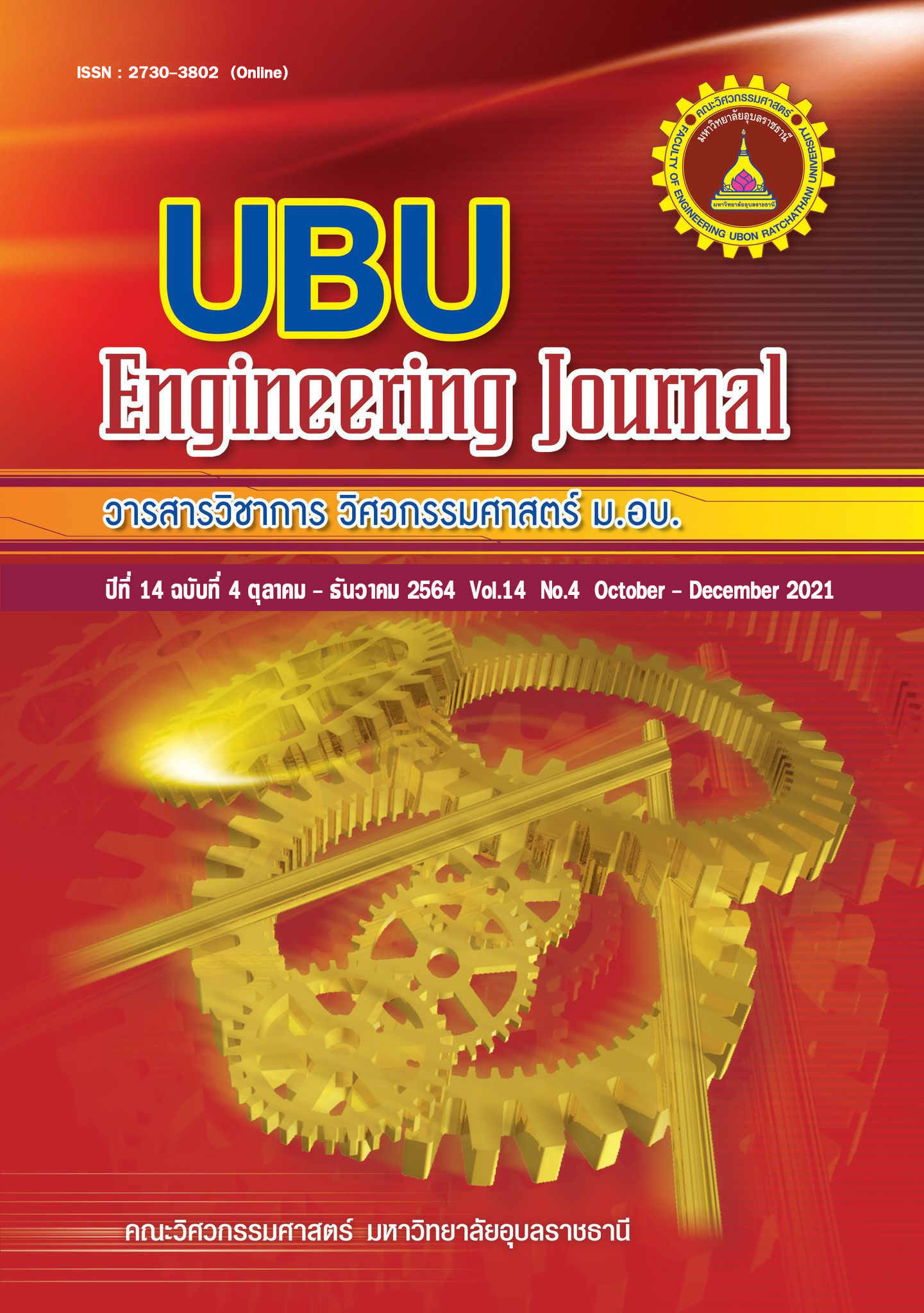Optimum Carburizing Temperature and Time in Hardening Big Knife by Pack Carburizing Process Using Golden Apple Snail Shells as an Energizer
Main Article Content
Abstract
The objective of this research was to study optimum factors; carburizing temperature and time that affected the mechanical properties of hardened big knives in pack carburizing process by using golden apple snail shell as an energizer. The mechanical properties which consisted of hardness and impact values were studied. These properties of the experiment were used for comparison with the mechanical properties vatues delivered from the big knives forged and hardened by communal forging knives. The pack carburizing compound used eucalyptus wood charcoal powder as carburizer with the proportion of 80 percentage and golden apple snail shell powder as energizer with the proportion of 20 percentage by weight. The two optimized factors in this study consisted of carburizing temperature and carburizing time. The carburizing temperature consisted of three levels such at 960, 980 and 1,000 degree Celsius. The carburizing time consisted of three levels of 60, 90 and 120 minutes. The carburizing experiment was conducted by following the principle of design of experiments (DOE). After carburizing, the knives were then austenitized at 780 degree Celsius for 15 minutes and quenched in water. After quenching, the knives were tempered at 180 degree Celsius for 60 minutes. The analyzed results showed that the carburizing temperature was 1,000 degree Celsius and the optimum carburizing time was 83.9 minutes. The two factors produced on average hardness of 606.8 HV and average impact value of 32.5 Joules. The optimum values of carburizing temperature and time were used for verification. The result of average hardness was 610.2 HV and the average impact value was 21.6 Joules, which coincided with the hardness of the communal big knives.
Article Details
References
[2] มนัส สถิรจินดา. วิศวกรรมการอบชุบเหล็ก. พิมพ์ครั้งที่ 4. โรงพิมพ์จุฬาลงกรณ์มหาวิทยาลัย. กรุงเทพฯ. 2538
[3] Elmi Hosseini S R, The Simulation of Case Depth of Cementation Steels According to Fick's Laws, Journal of Iron and Steel Researc, International. 2012: 71-78
[4] ณรงค์ศักดิ์ ธรรมโชติ วรรณา หอมจะบก นฤดม ทาดี. การเปรียบเทียบประสิทธิภาพในการเร่งปฏิกิริยาของสารเกรดทางการค้าชนิดต่างๆ ในการเพิ่มคาร์บอนที่ผิวของมีดโต้ที่ชุบแข็งด้วยกระบวนการแพ็กคาร์เบอไรซิง. วารสารมหาวิทยาลัยเทคโนโลยีราชมงคลอีสาน. 7(2) (2557): 67-80.
[5] สุภกร บุญยืน มณทา มาลัยนอก อภิสิทธิ์ โพธิ์แก้ว. การสลายตัวของแคลเซียมคาร์บอเนตในเปลือกหอย. วารสารวิทยาศาสตร์และเทคโนโลยี. 4(2) (2558): 115-122
[6] Teerawat Laonapakul, Ratchawoot Sutthi, Patamaporn Chaikool, Yoshiharu Mutoh, Prinya Chindaprasirt, Optimum conditions for preparation of bio-calcium from blood cockle and golden apple snail shells and characterization. Science Asia. 45(2019): 10-20
[7] Budi Hartono Setiamarga and Umen Rumendi. Comparison of the effectiveness of pack carburization energizers for surface hardening of low carbon steel. The 2nd AUN/SEED-Net Regional Conference on Materials Engineering: Material for Changing World. Faculty of Engineering. Burapha University. Thailand. November 2009: 19-20
[8] วรรณา หอมจะบก ณรงค์ศักดิ์ ธรรมโชติ นฤดม ทาดี. การเปรียบเทียบสารเร่งปฏิกิริยาระหว่างเปลือกไข่ไก่กับ CaCO3 ในกระบวกการแพ็กคาร์เบอไรซิง. วารสารวิจัย มหาวิทยาลัยเทคโนโลยีราชมงคลตะวันออก 8(1)(2558): 29-36
[9] ศักดิ์สิทธิ์ ศรีสุข ณรงค์ศักดิ์ ธรรมโชติ จารุพงษ์ บรรเทา จิตติวัฒน์ นิธิกาญจนธาร วรรณา หอมจะบก อมรศักดิ์ มาใหญ่ สมบัติ น้อยมิ่ง. การศึกษาความสัมพันธ์ของอุณหภูมิและเวลาที่ส่งผลต่อการชุบแข็งมีดโต้ในกระบวนการแพ็กคาร์เบอไรซิงโดยใช้สารเร่งปฏิกิริยาแคลเซียมคาร์บอเนต. การประชุมวิชาการการวิจัยดำเนินงานแห่งชาติ ครั้งที่ 16. เชียงใหม่, ประเทศไทย 7-8 กุมภาพันธ์ 2562: 201-207
[10] พีรวัตร ลือสัก กำพล จินตอมรชัย. การศึกษาการหาค่าพารามิเตอร์ที่เหมาะสม สำหรับแผ่นอัดจากเศษวัสดุธรรมชาติ. วารสารวิชาการ วิศวกรรมศาสตร์ ม.อบ. 2561; 11(1): 29–41.
[11] ณรงค์ศักดิ์ ธรรมโชติ วรรณา หอมจะบก. การชุบแข็งมีดทางการเกษตรโดยวิธีการเพิ่มคาร์บอนที่ผิวด้วยถ่านไม้สาหรับชุมชนตีมีดในจังหวัดนครราชสีมา. รายงานโครงการวิจัย 2555.
[12] Sidney H. Avner. Introduction to physical metallurgy. 2nd Edition. McGrall-Hill, Inc. Singapore. 1974: 246
[13] William F. Smith. Principle of Materials Science and Engineering. 3rd Edition. McGrall-Hill, Inc. USA. 1996
[14] Yahya Nukman and Hendri Chandra, The Carburizing Process of Low Carbon Steel with Charcoal Media Journal of Mechanical. Science and Engineering. 1(1) 2013: 1-6

